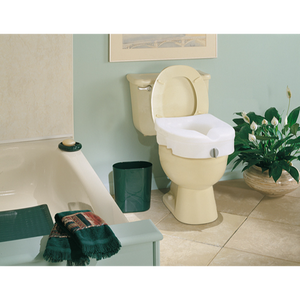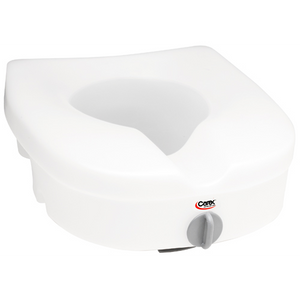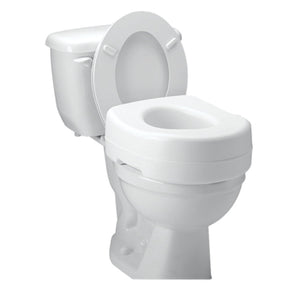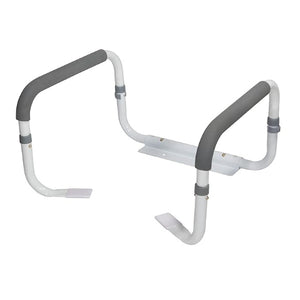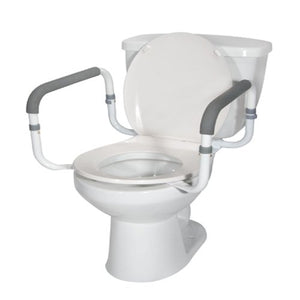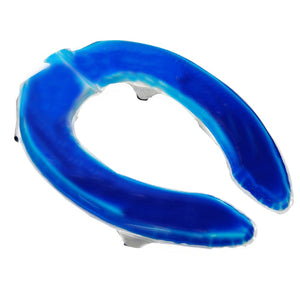To measure your toilet seat correctly, take three simple measurements: the distance between the bolt holes, the length from the bolt holes to the front of the bowl, and the width at the bowl’s widest point. This will help you choose the right toilet seat type, whether round or elongated, and avoid installation issues.
Why Measuring Your Toilet Seat Matters
Choosing the wrong toilet seat size can lead to discomfort, instability, and wasted time on returns. Whether you are upgrading to a soft close seat or a raised toilet seat for seniors, proper measurement ensures a secure and functional fit. This is especially important when shopping for mobility-focused bathroom aids.
How to Measure a Toilet Seat? Step-by-Step Process
Measuring a toilet seat is the first step in finding the perfect replacement. It's like taking the toilet seat's measurements to ensure you get the right fit.
Here's how you can measure your toilet seat:
1. Gather Your Materials
Before starting, ensure you have a measuring tape, a pen, and paper.
2. Remove the Existing Seat (if applicable)
If there's already a seat on your toilet, start by lifting it. Some seats are attached with screws, while others have a quick-release mechanism. If it's screwed on, you will need a screwdriver to loosen the screws.
3. Measure the Width
Place one end of the measuring tape on the outer edge of the seat on one side and extend it to the opposite outer edge. Ensure the tape is straight across and not slanted.
4. Measure the Length
Position the measuring tape at the front of the seat where you sit and extend it to the back. Again, ensure the tape is straight and aligned with the seat.
5. Note the Shape
Look down at the toilet seat from above. Is it more rounded or elongated? It will help you determine the seat's shape, which is crucial when shopping for a replacement.
6. Check for Hinges
Look at the method used to attach the hinges to the toilet bowl. Are they bolted on or connected with screws? Knowing this detail will ensure you choose a replacement seat with compatible hinge attachments.
7. Consider Special Features
Decide if you want special features in your new seat, such as soft-closing lids or quick-release mechanisms.
8. Double-check the Measurements
Once you have all the measurements and preferences noted down, take a moment to double-check them for accuracy. Finding the appropriate replacement seat requires exact measurements.
9. Shop for a Replacement
With your measurements and preferences, start looking for a replacement seat. You can visit a hardware store or browse online for options that match your criteria.
10. Install the New Seat
Follow the manufacturer's instructions to install the new seat properly. Here’s how you can do that:
- Clean the area: Spend a moment cleaning the toilet bowl and surrounding area to make sure there is no debris or residue there.
- Position the new seat: Match the holes in the toilet bowl with the holes in the new seat. Ensure the seat is facing the right way - the lid should be at the back when closed.
- Attach the new seat: Insert the bolts through the seat holes and into the corresponding holes on the toilet bowl. Then, secure the bolts with the nuts provided. Tighten them evenly to ensure the seat is stable.
- Adjust if necessary: Once the seat is attached, ensure it's appropriately aligned and sits on the toilet bowl. You can adjust the position if needed before fully tightening the bolts.
- Secure the hinges: If your new seat has covers for the hinges, snap them into place to cover the screws.
- Make final adjustments: If the seat feels loose, tighten the bolts. If it's too tight or misaligned, you may need to loosen the bolts slightly and readjust the position.
11. Test It Out
After installation, test the new seat to ensure it fits properly and functions as expected. Check for any instability or wobbling by sitting on it and raising and lowering the lid.
Choosing the Right Toilet Seat
Once you have the measurements, decide what features you need. A round toilet seat is compact and ideal for smaller bathrooms. An elongated toilet seat provides more sitting space and is often more comfortable.
Raised toilet seats are great for seniors or anyone recovering from surgery. Soft close and quick release options make cleaning easier and reduce noise. Plastic seats are durable and easy to clean while wooden seats offer a warmer, more traditional look.
Frequently Asked Questions (FAQs)
1. What is the standard toilet seat bolt-hole distance in the US?
Most US standard toilets have a bolt-hole spread of 5.5 inches. Measure the distance between the two holes at the back of the toilet to confirm.
2. Can I use an elongated toilet seat on a round toilet bowl?
No, it is not recommended. An elongated seat will overhang and not fit properly, which may cause discomfort and instability. Always match the toilet seat shape to the bowl type.
3. Do I need special tools to measure a toilet seat?
No. All you need is a standard measuring tape to check the bolt-hole distance, bowl length, and bowl width.
4. What type of toilet seat is best for seniors or people with limited mobility?
A raised toilet seat with handles or a soft-close elongated seat is ideal for seniors or those recovering from surgery. These provide better comfort, safety, and accessibility.
Conclusion
Measuring your toilet seat takes less than five minutes but can save you the hassle of poor fit and unnecessary returns. Whether you are replacing a broken seat or upgrading to a soft close or raised toilet seat for better comfort and hygiene, taking the correct measurements is the first step.
Looking for the perfect fit? Browse Moovkart’s collection of round and elongated toilet seats designed for comfort, durability, and style. From raised toilet seats for elderly users to soft close designer options, we have the right solution for every bathroom setup.
Visit Moovkart today and upgrade your bathroom experience with a seat that fits just right.


